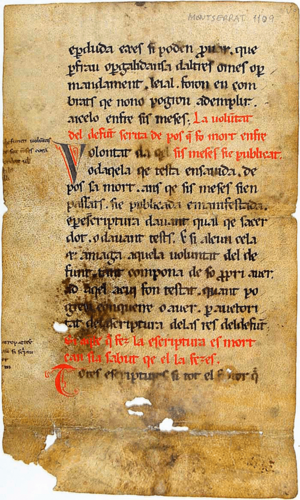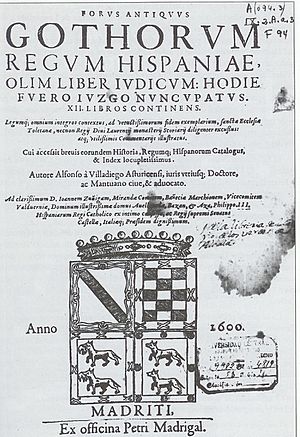Visigothic Code facts for kids
The Visigothic Code was a very important set of laws. It was also known as Liber Iudiciorum (which means "Book of the Judgements") or Lex Visigothorum ("Law of the Visigoths"). This code was first started by King Chindasuinth of the Visigothic Kingdom around 642 AD.
Later, in 654, his son, King Recceswinth, made the law code much bigger. This was a big deal because it was the first time that the same laws applied to everyone in the kingdom. Before this, the Goths (the conquerors) had their own laws, and the people with Roman backgrounds had different laws.
The Visigothic Code changed this. It meant that everyone in the kingdom, whether they were Goths or Romans, would follow the same rules. They all became "Hispani." This helped everyone in the kingdom feel more united and equal under the law. The code mixed ideas from Roman law, Catholic Church laws, and old Germanic customs.
Contents
Early Law Codes: Different Rules for Different People
For a long time, Romans and Goths in the Visigothic Kingdom lived under different laws. The earliest known Visigothic laws were called the Code of Euric, made around 480 AD.
Later, King Alaric II created laws for the Romans, who were most of the people in the kingdom. These laws were based on older Roman rules. This collection of laws, called the Breviary of Alaric, was announced in 506.
King Leovigild tried to combine the laws for Goths and Romans into one code called Codex Revisus. In 589, at the Third Council of Toledo, the Goths and Suebi, who had been Arian Christians, became Roman Christians (Catholic). Since everyone now shared the same faith, King Reccared made laws that applied to both groups equally.
The Visigothic Code: Laws for Everyone

The law code from 654 was made even bigger by King Recceswinth and later kings like Wamba, Erwig, Egica, and maybe Wittiza. King Recceswinth's code was put together by Braulio of Zaragoza. This was because King Chindasuinth's first code had been written very quickly.
In 681, during the Twelfth Council of Toledo, King Erwig asked for the law code to be made clearer and updated. Some new laws were added, including 28 that dealt with Jewish people.
These laws were very important and lasted for a long time. Even in the 10th century, people in Galicia still referred to the Code. The laws covered family life, like marriage, how property was passed down, and protecting the rights of widows and orphans.
The Visigothic Code was special for women. They could inherit land and titles. They could also manage their property on their own, without their husbands or male relatives. Women could write legal wills if they had no children. By age 14, they could speak for themselves and be witnesses in court. By age 20, they could even arrange their own marriages.
The laws also included rules from the Catholic Church's laws. This gave the code a strong religious feel.
The Visigothic Code was kept safe by the Moors (Muslim rulers) when they took over the Iberian Peninsula. Christians were allowed to use their own laws as long as they didn't go against the conquerors' rules. This meant the code was still used by Christian judges during Muslim rule.
Later, when Ferdinand III of Castile took Córdoba in the 1200s, he ordered his people to use the code. He had it translated into Spanish, though the translation wasn't perfect. This Spanish version was called the Fuero Juzgo. There was also an Occitan language translation, Llibre Jutge, which is one of the oldest writings in that language.
What the Visigothic Code Covered
The Visigothic Code was organized into different "books" and "titles," like chapters in a book. Here are some of the main topics it covered:
- Book I: Legal Agencies
- Rules about lawmakers and the law itself.
- Book II: Court Cases
- Rules for judges, how court cases should happen, and what to do with witnesses and evidence.
- Book III: Marriage
- Rules about wedding agreements, forbidden marriages, and how to get a divorce.
- Book IV: Family Matters
- Rules about family relationships, inheriting property, and guardians for children who lost their parents. It also had rules about abandoned children.
- Book V: Business and Property
- Rules for church matters, gifts, buying and selling things, loans, and freeing slaves.
- Book VI: Bad Actions and Punishments
- Rules about accusing criminals, people who do bad things, and murder.
- Book VII: Stealing and Cheating
- Rules about reporting theft, thieves, stolen property, and people who kidnap slaves. It also covered forging documents or making fake money.
- Book VIII: Violence and Damages
- Rules about attacks, stealing property by force, setting fires, and damaging plants or animals.
- Book IX: Runaways and Seekers of Safety
- Rules about people who run away, those who hide them, and soldiers who desert. It also covered people seeking safety in a church.
- Book X: Land and Borders
- Rules about dividing land, property limits, and marking boundaries.
- Book XI: Health, Death, and Traders
- Rules about doctors and sick people, disturbing graves, and merchants who came from other countries.
- Book XII: Preventing Abuse and Dealing with Different Beliefs
- Rules about judges being fair and stopping powerful people from being unfair. It also had rules about different religious groups, including new laws against Jews.
See also
 In Spanish: Liber Iudiciorum para niños
In Spanish: Liber Iudiciorum para niños
- Code of Euric
- Early Germanic law
- Fuero Juzgo
- Salic law
- Code (law)
Sources
- King, P. D. "King Chindasvind and the First Territorial Law-code of the Visigothic Kingdom." in Visigothic Spain: New Approaches. ed. Edward James. Oxford: Clarendon Press, 1980. pp 131–157.


